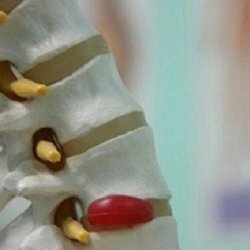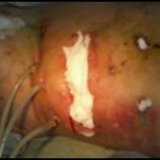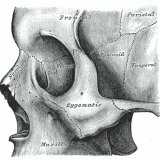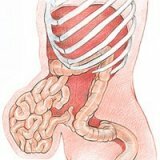Posterior median hernia in intervertebral disc
 Intervertebral hernia - this phenomenon is quite unpleasant, bringing a lot of problems to a person. And one of the most unpleasant options for this diagnosis is the back median hernia, located in the intervertebral disk. Consider what kind of ailment it is, how it should be treated and the reasons for its occurrence.
Intervertebral hernia - this phenomenon is quite unpleasant, bringing a lot of problems to a person. And one of the most unpleasant options for this diagnosis is the back median hernia, located in the intervertebral disk. Consider what kind of ailment it is, how it should be treated and the reasons for its occurrence.
How the posterior median hernia
is treated In general, the hernia is called "median" when the rupture of the cartilage of the disc occurs exactly along its radius. When it comes to the median anterior hernia, it is not so dangerous, the worst that awaits the sufferer in this case is the pain syndrome. But here is the back median hernia - this phenomenon is very insidious and much more dangerous for the patient.
It should be remembered that the posterior hernia in the spinal canal penetrates with all the ensuing consequences, namely compression of the spinal cord or the horse's tail, which causes the innervation of internal organs or limbs. In the specification of all possible negative consequences, there is no special meaning, since it is very easy to understand what the patient is threatened with a neglected variant of the disease.
There is still a difficulty - the treatment of the posterior median hernia is much more complicated. It is "hidden", and it is difficult to get to it. Even if successfully managed to "get" to the site of localization of this problem, this situation does not facilitate, since the surgeon has to work "in close contact" directly with the spinal cord. Therefore, any wrong movement can lead to irreversible consequences.
This type of hernia in most cases requires urgent surgical intervention. If, with other hernias, the indication for surgical intervention is mainly pain, in this case the situation is much worse, here we are talking about the correctness of the activity of many internal organs. But on the other hand, specialists do not want to go to risk anyway( which is always present during the surgical removal of such a hernia) and try to eliminate the problem by conservative methods. It should be noted that more often it is possible - our body has great opportunities in self-recovery.
Conservative treatments are also common, which make it possible to do without surgery. But in most cases with this type of intervertebral hernia operation is still necessary. When pain can not be eliminated by conservative methods, the hernia itself begins to influence the work of internal organs.
Conservative treatment is prescribed for almost all patients. Only in the absence of the desired effect, surgical intervention is prescribed.
In general, this treatment of hernia begins with the appointment of bed rest, after which a limited activity regime is already appointed. Such measures should allow the spine to relax and relax, thereby reducing the compression of nerve roots.
Both medical treatment starts simultaneously. The most active anti-inflammatory non-steroid drugs are used. They reduce edema and relieve inflammation, thereby relieving pain. But these drugs have a drawback, so they can not be used for a long time, since negative side effects begin to occur, in most cases in the zone of the gastrointestinal tract. Therefore, the doctor must measure the expected benefit with the likely risk of such a side effect.
With significant pain syndromes, pain medication is also used. With them, too, not everything is simple. The psychology of a person perceives everything in such a way that when there is no pain, then there is no disease. Therefore, when the pain recedes, the patient begins to move more actively, thereby increasing the burden on the spine. However, the disease has not disappeared anywhere, and as soon as the action ends, the pain will "pile up" again. Because doctors are less likely to use analgesics, applying them only with quite strong pain syndromes.
After the pain has been taken under control, proceed to the next phase of treatment. In this case, various physiotherapeutic methods of treatment are used, but the basis is still therapeutic gymnastics and massage. Individual exercises allow to bring the muscular corset back to normal, and also to provide the necessary amount of physical activity, which makes it possible to create conditions for normal metabolism in the spine zone.
Treatment of a posterior median hernia allows most patients to be relieved of the problem, but the patient must understand that it is necessary to change his lifestyle.
Why does such a hernia appear?
Almost all patients with this diagnosis have this issue. First of all, one must understand that the human spine is a perfectly balanced, very reliable mechanism. Like any other mechanism, it has the property of "weakening", as well as "breaking down" when the conditions of its application are far from those envisaged. In this case, attention is focused on intervertebral discs.
For normal development of the spine, often not enough nutrients are needed, as well as trace elements. Therefore, not only in the elderly age there is a hernia, but also in young people. But this is only the first problem, which more or less people calmly decide.
There is a more serious problem - this is a sedentary lifestyle. This is critical because the intervertebral disc of its blood vessels does not have, therefore it is forced to receive "food" in a somewhat unusual way - by diffusion from the surrounding tissues. And in order for the diffusion process to take place with the required efficiency, physical loads and movements are needed. Otherwise, even if you eat right and have all the necessary trace elements in the body, they can not get into the intervertebral disc without movements.
What happens to the intervertebral disc when it does not receive the necessary "nutrition"?It's simple - it gradually begins to lose its properties. The pulp core of the disc loses water, because of which the damping property of the disc itself disappears. In the conditions of a lack of the necessary elements, problems also arise in the fibrous ring holding the disc in a natural place. Such a ring begins to "weaken", gradually, cracks begin to appear on it. Load on the disk at the same time did not decrease, and in many cases - even increased( when a person gained weight).
Fibrous ring sooner or later does not withstand the pressure of the nucleus, so it begins to recede, protrude, and as a result protrusion is formed - this is the first stage of hernia formation. Since the formation of protrusions is almost never accompanied by symptoms, the patient does not even suspect the problem. It takes a little time, and the fibrous ring simply does not stand up and there is a full intervertebral hernia.
The main causes of posterior hernia are also various types of spine trauma.



